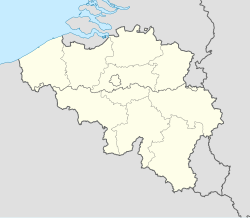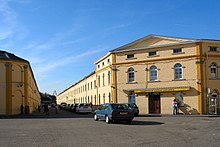
Wallonia, officially the Walloon Region, is one of the three regions of Belgium—along with Flanders and Brussels. Covering the southern portion of the country, Wallonia is primarily French-speaking. It accounts for 55% of Belgium's territory, but only a third of its population. The Walloon Region and the French Community of Belgium, which is the political entity responsible for matters related mainly to culture and education, are independent concepts, because the French Community of Belgium encompasses both Wallonia and the bilingual Brussels-Capital Region but not the German-speaking Community of Belgium, which administers nine municipalities in Eastern Wallonia.
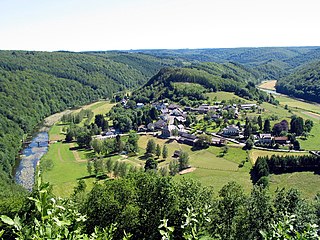
The Ardennes, also known as the Ardennes Forest or Forest of Ardennes, is a region of extensive forests, rough terrain, rolling hills and ridges primarily in Belgium and Luxembourg, extending into Germany and France.

Hainaut, historically also known as Heynault in English, is the westernmost province of Wallonia, the French-speaking region of Belgium.

Charleroi is a city and a municipality of Wallonia, located in the province of Hainaut, Belgium. It is the largest city in both Hainaut and Wallonia. The city is situated in the valley of the Sambre, in the south-west of Belgium, not far from the border with France. By 1 January 2008, the total population of Charleroi was 201,593. The metropolitan area, including the outer commuter zone, covers an area of 1,462 square kilometres (564 sq mi) with a total population of 522,522 by 1 January 2008, ranking it as the 5th most populous in Belgium after Brussels, Antwerp, Liège, and Ghent. The inhabitants are called Carolorégiens or simply Carolos.

Binche is a city and municipality of Wallonia, in the province of Hainaut, Belgium. Since 1977, the municipality consists of Binche, Bray, Buvrinnes, Épinois, Leval-Trahegnies, Péronnes-lez-Binche, Ressaix, and Waudrez districts.
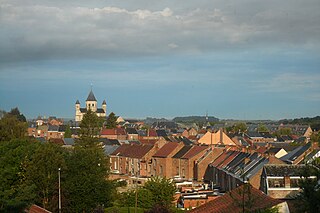
Nivelles is a city and municipality of Wallonia located in the Belgian province of Walloon Brabant. The Nivelles municipality includes the former municipalities of Baulers, Bornival, Thines, and Monstreux.

Malmedy is a city and municipality of Wallonia located in the province of Liège, Belgium.
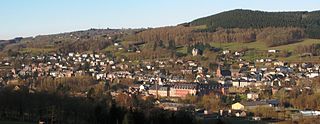
Stavelot is a town and municipality of Wallonia located in the province of Liège, Belgium.
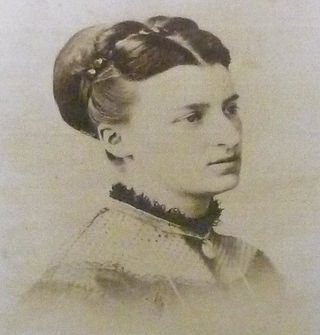
Anna-Rosalie Boch, known as Anna, was a Belgian painter, art collector, and the only female member of the artistic group, Les XX. Born in Saint-Vaast, Hainaut. Anna Boch died in Ixelles in 1936 and is interred there in the Ixelles Cemetery, Brussels, Belgium.

The Haine is a river in southern Belgium (Hainaut) and northern France (Nord), right tributary of the river Scheldt. The Haine gave its name to the County of Hainaut, and the present province of Hainaut. Its source is in Anderlues, Belgium. As the western end of the sillon industriel, Wallonia's industrial backbone, it flows through the heavily industrialized Borinage region, notably the towns La Louvière, Mons and Saint-Ghislain. A few kilometres after crossing the border into France, the Haine flows into the Scheldt in Condé-sur-l'Escaut. Its length within Belgium is 72 km (45 mi) and the Belgian part of its drainage basin is 802 km2 (310 sq mi).
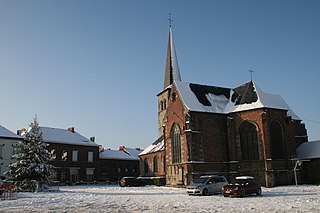
Havré is a sub-municipality of the city of Mons located in the province of Hainaut, Wallonia, Belgium. It was a separate municipality until 1977. On 1 January 1977, it was merged into Mons.

The Sillon industriel is the former industrial backbone of Belgium. It runs across the region of Wallonia, passing from Dour, the region of Borinage, in the west, to Verviers in the east, passing along the way through Mons, La Louvière (Centre-region), Charleroi, Namur, Huy, and Liège. It follows a continuous stretch of valleys of the rivers Haine, Sambre, Meuse and Vesdre, and has an area of roughly 1000 km2.
The history of Wallonia, from prehistoric times to the present day, is that of a territory which, since 1970, has approximately coincided with the territory of Wallonia, a federated component of Belgium, which also includes the smaller German-speaking Community of Belgium. Wallonia is the name colloquially given to the Walloon Region. The French word Wallonie comes from the term Wallon, itself coming from Walh. Walh is a very old Germanic word used to refer to a speaker of Celtic or Latin.

Union Royale La Louvière Centre is a Belgian association football club based in La Louvière, in the province of Hainaut. Created in 1922 and the team currently play in Belgian Division 2, the fourth tier of Belgian football.
Strépy-Bracquegnies is a village in Wallonia, Belgium. It is a district of the municipality of La Louvière in the province of Hainaut. It is around 6 km west of the centre of La Louvière, and around 50 km south-west of Brussels.

The Bois-du-Luc was a coal mine in Houdeng-Aimeries, near La Louvière, in Belgium which today is preserved as an industrial heritage site. As well as the site of the headquarters of the Société des Charbonnages de Bois-du-Luc et d'Havre, the Bois du Luc was the site of the Saint Emmanuel Pit which belonged to the company. The Fosse Saint-Emmanuel was one of the oldest mines in Belgium, with recorded activity dating back to 1685. The company ceased mining in 1973.

The Laetare of Stavelot is a traditional carnival that occurs every Laetare Sunday in Stavelot, Liège Province, Belgium. This tradition, in Belgium's Wallonia region, is also known for its principal attraction: the "Blancs Moussis".

Sart-lez-Spa is a village of Wallonia and a district of the municipality of Jalhay, located in the province of Liège, Belgium.

Trivières is a village of Wallonia and a district of the municipality of La Louvière, located in the province of Hainaut, Belgium.

Houdeng-Aimeries is a village of Wallonia and a district of the municipality of La Louvière, located in the province of Hainaut, Belgium.




